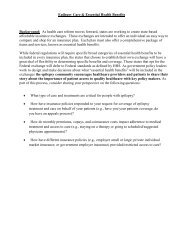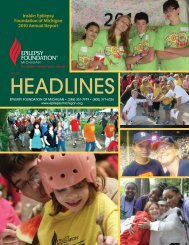Legal Rights of Children with Epilepsy in School & Child Care
Legal Rights of Children with Epilepsy in School & Child Care
Legal Rights of Children with Epilepsy in School & Child Care
You also want an ePaper? Increase the reach of your titles
YUMPU automatically turns print PDFs into web optimized ePapers that Google loves.
The Special Education Process for <strong><strong>Child</strong>ren</strong> <strong>with</strong> <strong>Epilepsy</strong>: The Individuals <strong>with</strong> Disabilities Education Act (IDEA)<br />
restrictive. In the least restrictive placements, students <strong>with</strong> disabilities are<br />
educated <strong>with</strong> students <strong>with</strong>out disabilities, and <strong>in</strong> the most restrictive<br />
placements, they are educated only <strong>with</strong> other students <strong>with</strong> disabilities or, as <strong>in</strong><br />
the case <strong>of</strong> home teach<strong>in</strong>g, no other students.<br />
4.29Q: How is a special education placement made?<br />
A: A group <strong>of</strong> people knowledgeable about the student, his or her evaluation data,<br />
and placement options must make placement decisions. The group must <strong>in</strong>clude<br />
the student’s parents. 34 C.F.R. 300.116(a)(1); 34 C.F.R. 300.327. Generally,<br />
the IEP team determ<strong>in</strong>es where the IEP can be implemented. Placement must be<br />
determ<strong>in</strong>ed at least annually and must be based on the student’s IEP. 34 C.F.R.<br />
300.116(b). In mak<strong>in</strong>g placement decisions, the team must place the student <strong>in</strong><br />
the least restrictive environment <strong>in</strong> which the IEP can be implemented.<br />
4.30Q: What is placement <strong>in</strong> the “least restrictive environment”?<br />
A: The IDEA requires that students be placed <strong>in</strong> the least restrictive environment <strong>in</strong><br />
which their needs can be met. This means that if possible, a student should be<br />
placed <strong>in</strong> the general education classroom <strong>with</strong> students who are not disabled. 34<br />
C.F.R. 300.114. The school has an obligation to provide supplementary aids and<br />
services to the student and programmatic supports and modifications to school<br />
staff <strong>in</strong> an effort to educate the student <strong>in</strong> the general education program. 34<br />
C.F.R. 300.114; 300.320(a)(4). Students <strong>with</strong> disabilities should attend the<br />
school they would attend if not disabled, unless their IEPs require some other<br />
arrangement, and should attend the school closest to home (“neighborhood<br />
school”), unless their IEPs require some other arrangement. 34 C.F.R.<br />
300.116(b)(3) and (c). 34<br />
4.31Q: Does a school district have any responsibility to students to help them be<br />
placed successfully <strong>in</strong> less restrictive sett<strong>in</strong>gs?<br />
A: Yes. Only if the student cannot be educated satisfactorily, even <strong>with</strong> the use <strong>of</strong><br />
supplementary aids and services, should he or she be moved to a separate class<br />
or school. 34 C.F.R. 300.114.<br />
4.32Q: Must a school district place a student <strong>in</strong> a general education classroom if it<br />
would be harmful to the student?<br />
A: No. In determ<strong>in</strong><strong>in</strong>g the least restrictive environment possible for a student, the<br />
IEP team must consider any potential harmful effects on the student or on the<br />
quality <strong>of</strong> services that he or she needs. 34 C.F.R. 300.116(d).<br />
34 See discussion <strong>of</strong> least restrictive environment cases at the end <strong>of</strong> this chapter for more <strong>in</strong>formation.<br />
49








